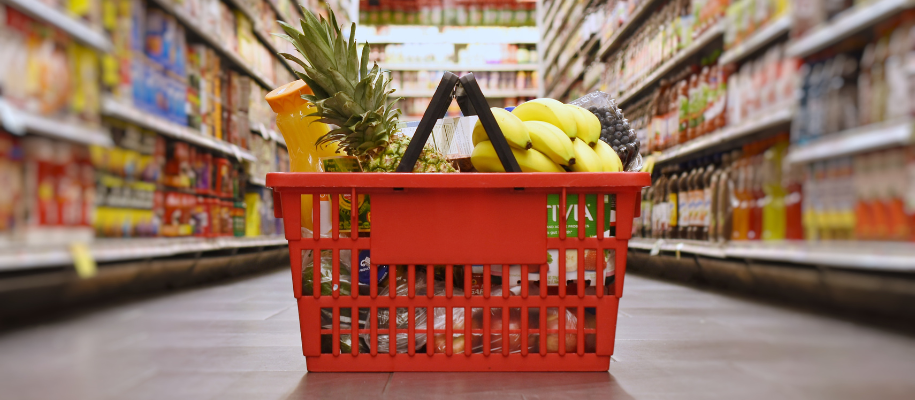I ditched dorm life after my first year of college because my roommate and I decided we wanted a kitchen. We were both sick of eating on campus, and neither of us could afford to eat out all the time. So at the beginning of sophomore year, we moved into an on-campus apartment. Once we had all our furniture, clothes, and dishes put away, we went grocery shopping. That first time completely overwhelmed me; I had never grocery shopped for just myself. I come from a family of five, so my food-shopping experiences with my mom ended in a cart piled high and a pricey bill almost every time. I had no idea how to shop for just myself. It took me a couple of months to figure out what and how much to buy to feed myself, not waste food, and save money. Here’s a good basic college grocery list and a bunch of tips on how to do it right.
Plan before you go shopping
Make a list of what you eat for at least a week or two before you really need to fill up your kitchen, that way you know what you actually need to buy. For example, my family keeps a lot of cereal at home, but I prefer yogurt for breakfast. So in college, I started buying cereal like my parents did but realized I just let it go stale. You don't have to buy things simply because it's what you're used to. Once you have a good consistent list to return to, look to see what kind of foods are on it. Are you eating a lot of meat? Try to add some more veggies in there. Are you buying a lot of fruit to snack on? Make sure you also get nonperishable snacks for when you run out in case you get busy.
Use your school and work schedule to see how many meals you realistically need to buy for each week. You’ll also figure out if you need to look for super easy or even premade meals (keep in mind those are usually more expensive) or if you have spare time to spend on extra food prep for the week. If you have the time, look up some simple recipes to make that'll be inexpensive to buy food for. Make a list of the ingredients they require so you don’t forget something while you’re shopping—or buy extra stuff you don’t need.
Pro grocery shopping tip: If you know you want to cook and bake in college, you’ll need your basics. Get some flour, sugar, baking soda, cocoa, and spices you use often (if you haven’t used spices before, Italian seasoning, garlic, and taco seasoning are good places to start). This will be more expensive than your average grocery shop, but you won’t need to replace these items often.
Related: The Ultimate Vegetarian and Vegan Guide to Good Eating in College
Determine your budget
Everything is expensive these days, and certain items are going to be more expensive than others. I’ve found that I spend more on groceries on weeks I buy meat than on weeks I don’t. Compare meat prices when you get to the store too. Usually, prepackaged meat is cheaper, but occasionally the butcher counter will have good deals. If I get meat, I typically stick to smaller portions or, if I can get a good deal, freeze as much as I can right away. Depending on how much I cook, this can last a month or two. It may be different if you buy a lot of frozen or organic food. Don’t panic too much if you go over your grocery budget the first few times; it’s all about finding out what feels essential to you and what you can cut back on. Also, look for deals and coupons. There are lots of money-saving apps and websites with coupons, but don’t get suckered into buying food you don’t really need just because you got a coupon for it!
Pro grocery shopping tip: Once you know what you typically buy in a given week, see if your grocery store has an app and a rewards program. Usually, apps will have a reward card that you can add points or coupons to. Coupons are applied automatically at checkout, and it’s a relatively quick way to save a little each week.
Stay focused while shopping
The first time you shop by yourself, it can be good to go down every aisle to get a sense of your local grocery store’s layout. But aisles can be treacherous because that’s where you’ll find all the foods with lots of salt, sugar, and preservatives—like the snacks. Aisles are also typically laid out so your eyes and brain trick you into buying the bad stuff. So try to stick to the perimeter of the grocery store if you can, and venture into the aisles only when you need something specifically. When you’re done shopping, look at your cart before you check out. Do have everything on your list? Are you all set for breakfast, lunch, dinner, and snacks? Did you grab a bunch of things that weren't even on your list? I’ve made the mistake of buying mostly snack food and not having anything for dinner, and I end up going out when I'm trying not to.
Pro grocery shopping tip: You really do spend more money at the grocery store if your tummy is rumbling, and you will end up forgetting to buy items you need because you’re in a hurry to leave and get home to eat. I have done this. Don’t be like me.
Related: The Best Study Snacks for Healthy Eating in College
Keep your pantry and fridge relatively organized
Cooking and eating healthy—and saving money—is much easier with an organized food space. I once had a roommate who bought a bottle of cooking oil every week because she either forgot she had it or couldn’t find it because her shelf was so unorganized. Try to keep the stuff you use often near the edges of shelves or at the front of cabinets for easy access. If you buy meats or breads, decide how much (if any) you want to freeze. I try to separate my meat into single-pound units and freeze those by themselves because that’s how much I typically use in a single recipe. Get reusable containers that can be frozen (also for your leftovers) or food packaging material like cellophane and aluminum foil. Also, be sure to put the date it was frozen so you know what to use first. You can even buy frozen vegetables so you don't have to worry about them spoiling as quickly. Contrary to popular belief, frozen veggies are still super good for you!
Pro grocery shopping tip: Every month or so, go through your pantry and fridge to see what you have and clean out stuff that's been there for too long. You might get more ideas for things to cook, and you won’t let certain items get too gross if you forget about them.
College grocery list ideas
These simple and basic foods are cheap, healthy, and widely available. Obviously, you can buy whatever you like best, but this is just to get you started. This list includes some great choices for college students on a budget! Many even work well in a dorm if you have a mini fridge and microwave.
- Apples, bananas, and other fruits
- Bell peppers, spinach, onions, and other veggies
- Cereal (dry cereal also makes a quick snack)
- Cheese sticks
- Coffee (making it yourself can save you tons of money)
- Eggs
- Garlic
- Hummus
- Lentils and beans
- Oatmeal
- Peanut butter
- Popcorn
- Rice (brown rice for an extra healthy option)
- Chips and salsa
- Sweet potatoes
- Tortillas
- Tuna fish (look for low sodium)
- Whole grain bread
- Whole wheat pasta
- Yogurt
Related: The Best College Meals for Your Taste Buds and Budget
Grocery shopping can be overwhelming, especially for a college student, but it doesn’t have to be. As I’ve gotten more comfortable, I’ve begun to enjoy cooking and trying new recipes. I’ve started eating healthier too, because I’m more conscious of what I buy when I shop for food. I don’t want to waste my money on junk! Learning how to grocery shop has been a process, but it’s also been fun. Hopefully, these tips will make it easier to enjoy the fun part of buying food on your own in college.
If complex, time-consuming meals aren't your thing, we've got your back. Tyler's Ultimate College Cooking Collection: All the Best Microwave Recipes can teach you how to make delicious food with ease!






